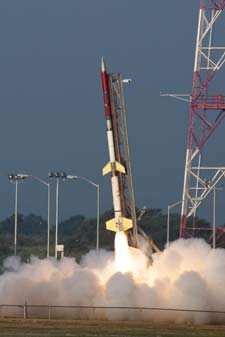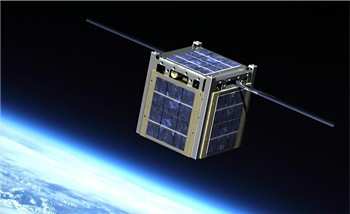Microsatellite To Fly On Orion Rocket June 9
A new microsatellite designed to give scientists less expensive
access to space will be demonstrated during a NASA Terrier-Improved
Orion suborbital sounding rocket flight between 0700 and 1000
EDT June 9, from NASA's Wallops Flight Facility in Virginia.
The backup launch day is June 10.

Terrier Orion Sounding Rocket
The Small Rocket/Spacecraft Technology (SMART) platform, created
by engineers at the Goddard Space Flight Center, Greenbelt, MD, and
the Department of Defense Operationally Responsive Space (ORS)
Office at the Kirtland Air Force Base in New Mexico, is designed to
provide faster, less expensive access to space because of its
modular, reconfigurable design. Users can adapt SMART to fulfill a
variety of missions ranging from optical imaging to radio-frequency
applications.
Comparable in size to an old-fashioned hatbox, measuring nearly
16 inches in diameter, the SMART microsatellite can be integrated
and readied for launch in as few as seven days for less than $1
million, said Goddard engineer Jaime Esper, platform designer.
"We've developed a creative way to reduce mission life-cycle times,
with the resulting savings in cost. This enables a new class of
researchers who can't afford the high costs of getting into
space."
SMART will be installed on the Suborbital Technology Carrier
(SubTEC) that Wallops engineers developed to help mature emerging
technologies faster. The carrier consists of two experiment
sections and a suite of support instrumentation that can be
retrieved, refurbished, and reused after each flight. "The SubTEC
program is providing a great way to demonstrate Goddard
technologies. With SMART, that capability is further enhanced,"
Esper said. "I think we need to leverage our expertise to create
more opportunities for scientists and technologists who need
low-cost access to space to advance their technologies."
Although SMART is debuting on a suborbital flight, Esper said
the platform is intended for orbital missions, particularly as a
freeflyer that could be used, for example, as an entry vehicle for
planetary missions. To demonstrate that capability, SMART is
equipped with three digital video cameras and environmental and
positional sensors serviced by the SpaceCube processor.

SpaceCube, also developed by Goddard engineers, is 25 times
faster than the current state-of-the-art microprocessor. It will
process data-heavy video to test high-speed interfaces and monitor
the deployment of SubTEC's recovery parachute.
Another objective is demonstrating SMART's prowess as a platform
for testing Autonomous Flight Safety System (AFSS) software. The
technology, being developed by Wallops engineers, would order a
rocket to self-destruct if it swerved off course during launch.
Traditionally, range-safety officials use radar from ground
stations to track flight vehicles and ground-based command systems
to abort wayward rockets. Automating these systems may reduce costs
and enhance public safety, Esper said.
SMART is ideal for this application because it couples
SpaceCube's processing powers with advanced avionics systems, Esper
added. It also comes equipped with an inertial measurement unit and
a GPS receiver to determine its precise attitude, location and
velocity at all times during the launch. With the avionics data,
SpaceCube would run the software to analyze whether the rocket had
veered off course. If it had, the software would initiate an abort
command.

Also onboard SMART is the Wallops-developed Low Cost Telemetry
Transmitter (LCT2), another range-safety technology. The goal with
this technology is to eventually eliminate the need for tracking
stations down-range, saving money and providing rapid access to
vehicle-performance data anywhere, anytime.
Another emerging new technology installed on SMART is an
electrohydrodynamic-based thermal control unit. The technology uses
electric fields to pump coolant through tiny ducts inside a thermal
cold plate. The advantage is that the system requires no moving
parts, just electrodes to apply the voltage to move the
coolant.
 ANN's Daily Aero-Linx (04.15.24)
ANN's Daily Aero-Linx (04.15.24) Classic Aero-TV: 'No Other Options' -- The Israeli Air Force's Danny Shapira
Classic Aero-TV: 'No Other Options' -- The Israeli Air Force's Danny Shapira Aero-News: Quote of the Day (04.15.24)
Aero-News: Quote of the Day (04.15.24) Airborne 04.16.24: RV Update, Affordable Flying Expo, Diamond Lil
Airborne 04.16.24: RV Update, Affordable Flying Expo, Diamond Lil ANN's Daily Aero-Term (04.16.24): Chart Supplement US
ANN's Daily Aero-Term (04.16.24): Chart Supplement US





